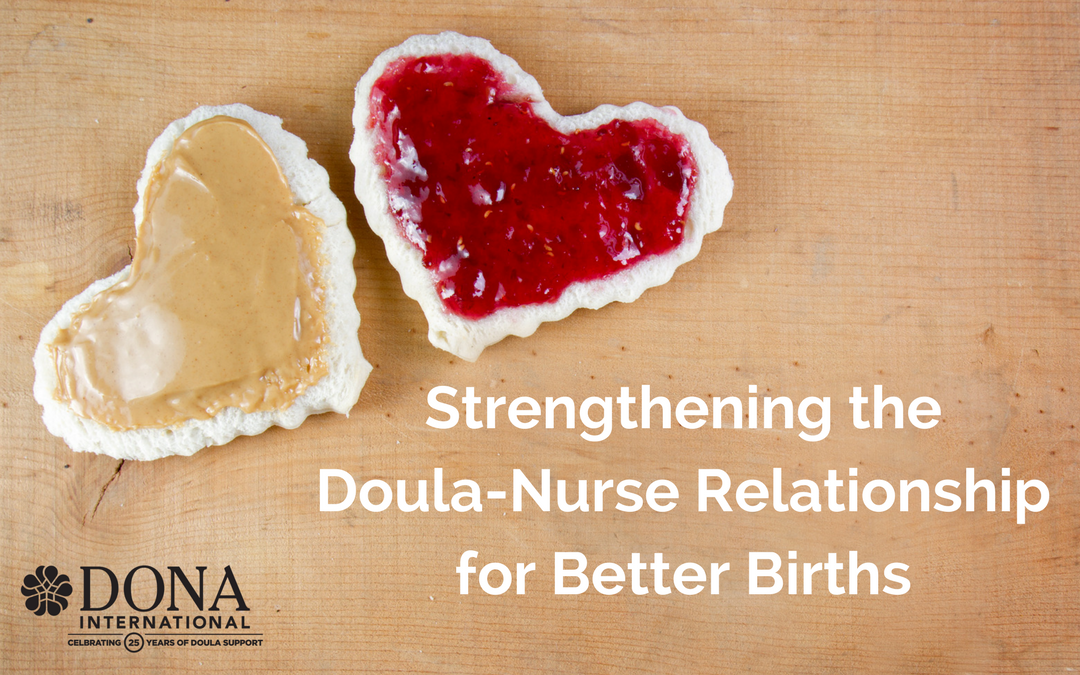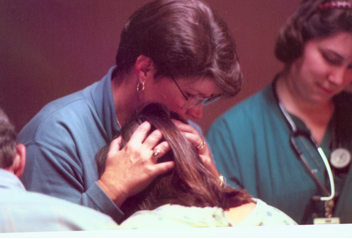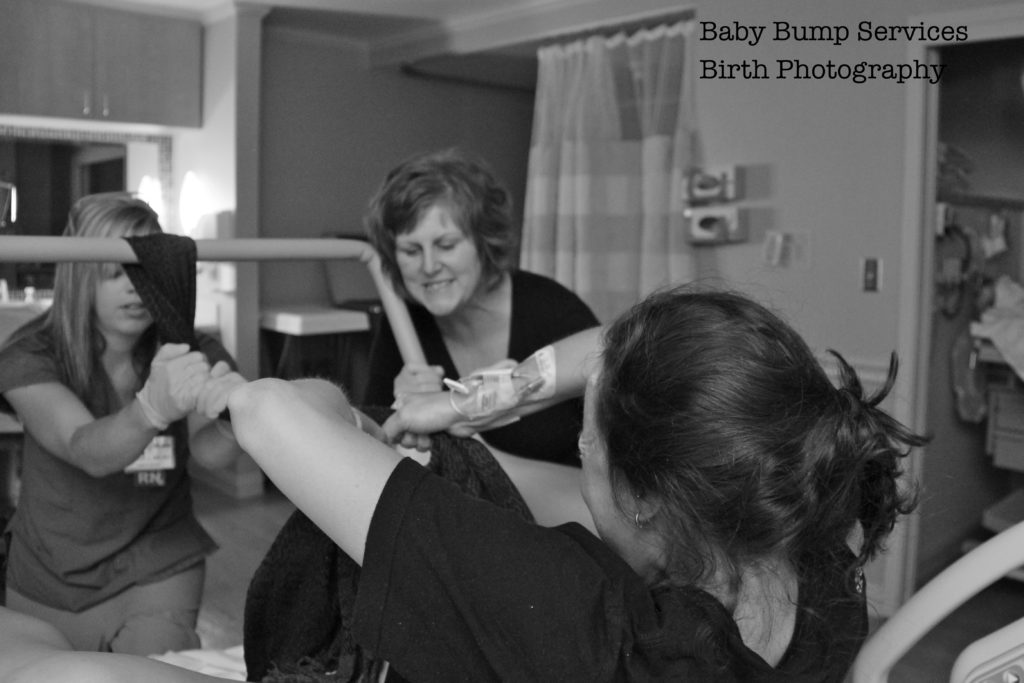By Ann Tumblin, LCCE, FACCE, CD(DONA), BDT(DONA)
Today, Ann Tumblin reviews a study published last fall that looks at how doulas and labor & delivery nurses view each other in the workplace. Every DONA doula learns that DONA International’s Code of Ethics requires Primacy of Client’s Interests which means that the doula’s primary responsibility is to their clients. But doulas are also aware of the need for collaboration between themselves and healthcare providers, including the labor and delivery nurse in order for the experience to be a positive one for their clients.
Ann reviews this research which examines the attitudes that doulas and labor and delivery nurses have towards each other. She also gives some practical advice gleaned from her many years as a doula, trainer and childbirth educator. Ann’s tips will help a birth doula to learn how to foster a positive relationship with the nurses assigned to their doula clients. – Sharon Muza, Blog Manager
Doulas and nurses
Doulas and nurses have worked side by side in hospitals for many years, serving families in labor. As one can imagine, this relationship has the potential to range from a completely positive experience to one that is fraught with tension and conflict for both the doula and the nurse. This conflict can detract from the family’s experience and memories of their birth. I was excited to read a 2016 research paper “North American Nurses’ and Doulas’ Views of Each Other” published in the Journal of Obstetrical, Gynecological and Neonatal Nursing (JOGNN) that covered exactly this topic. As a long time doula and doula trainer as well as teaching childbirth education in a tertiary care maternity center for over 26 years, I was curious if the research article would concur with my acquired perceptions of the doula and nurse’s views of each other.
How was the study done
The researchers started the project with five hypotheses:
1. Doulas who work primarily in one hospital, earn more money from doula work, and/or are certified, will have more positive views of nurses.
2. Nurses who work in hospitals where doulas attend a higher percentage of births and those nurses with more years of experience will have more positive views of doulas.
3. Nurses who work more hours, attend more births per shift, and feel overworked will have more negative views of doulas.
4. Nurses who value labor support as much as, or more than, clinical tasks involved in the observation and treatment of their patients, will have more positive views of doulas.
5. Nurses with more positive attitudes toward typical obstetric protocols will have more negative views of doulas, whereas doulas with more positive attitudes toward typical obstetric protocols will have more positive views of nurses.
Study participants were recruited from nursing, doula and childbirth education organizations (including DONA International) across the USA and Canada. Childbirth educators were included if they also worked as a birth doula. Additionally, social media was used as a means of publicizing the call for respondents. 1,470 doulas and 704 nurses ultimately were included in the research analysis. Demographical information, training background, and credentials were collected on the study participants. Respondents were asked about their sources of information and knowledge about birth, financial rewards of maternity support work, childbirth and breastfeeding experience, attitudes toward common labor practices and breastfeeding, attitudes toward other maternity support roles, work experiences including ethical challenges, work satisfaction and burnout, hospital characteristics, understandings of informed consent, experiences with and knowledge of quality improvement initiatives, and questions specific to each maternity support role.
Study results
Doulas who work primarily in one hospital and were certified had more positive reviews of nurses. This confirmed the original hypothesis. This may be because doulas are more likely to develop relationships with labor and birth nursing staff that may improve the attitudes of nurses and doulas toward each other. This research states that doulas vary in their level of professionalism. Certified doulas may also be more likely to respect boundaries between their role and that of nurses and may be more open to building positive relationships with clinicians.
Doulas with more positive attitudes toward common obstetrical practices (mainly, induction and use of epidural) had more positive views of labor and birth nurses. This also confirmed the hypothesis. It should be noted that this varied regionally and doulas in the northeastern or southern United States and Canada had significantly more negative views of nurses than doulas in the western part of US.
Nurses with positive attitudes toward common medical practices in maternity care had significantly more negative views of doulas. This also was in line with the original hypothesis.
Nurses who enjoyed doing labor support more than clinical tasks had more positive views of doulas, again confirming the hypothesis.
This study shows that nurses and doulas did not always share the same opinion of each other and indicates there are still turf issues present. This may be because of professional centrism. Professional centrism is a preferred view of the world held by a particular occupational group; unfortunately, professional centrism leads to biased thinking that is based on stereotypes and prejudices (Pecukonis et al., 2008). When one professional group views their profession as more central or important than that of another group, this can negatively influence interdisciplinary cooperation.
Certified doulas had a more positive view of nurses, and it is possible that certification education and the certification process helped these doulas by encouraging collaboration. It seemed apparent that nurses who were overworked might consider a doula as a disruption to routine care. Even though a doula could help with labor support, nurses with unfavorable opinions of doulas may have perceived that doulas’ labor support activities as an increase to their workload because doulas were another member of the birth team to direct, receive reports from, thereby adding to their work. It was also apparent that not all nurses enjoyed the labor support part of their role.
Doulas may have more knowledge of physiologic labor support but lack a clinical perspective and awareness of when medical interventions are indicated. There are times when nonpharmacologic comfort measures and continuous support must be supplemented with skilled professional care.
Of course, as in all research, it was mentioned that further research could be developed for this issue. Some suggestions from this data included the following and I quote:
- “The practice of mutual introductions while in the presence of the woman in labor.
- An agreement for nurses and doulas to show respect to each other through verbal and nonverbal communication.
- Debriefs with mutual evaluation of communication, behavioral, and outcome data.
- Participation in role-specific workshops to clarify doula roles and demonstrate labor support techniques to nurses and show nursing scope and goals of practice to doulas.
- One-on-one shadowing among newly trained L&D nurses and doulas to learn the other’s role and compare and contrast with their own role.
- Attendance at joint educational conferences between nursing and doula organizations.”
In psychology, the exposure effect refers to the idea that mere repeated exposure of individuals to the same stimulus will enhance their attitudes toward it (Akhavan & Lundgren, 2012; Zajonc, 1968). It follows that L&D nurses with repeated exposure to doulas would develop more positive attitudes toward them. It is possible that as more and more doulas attend births with clients, the labor and delivery nurses’ attitudes will shift toward an overall positive one. In 2013, six percent of birthing people had a doula in attendance (Declercq, 2013). One can only imagine this number will increase as the number of families using doulas continues to climb.
My professional experience
As someone who is not a nurse but worked very closely with nurses and management in a large maternity care hospital for 26 years, this study provided interesting information – but nothing new for me. I was employed there as a Lamaze Certified Childbirth Educator but had experiences outside the childbirth education classroom providing tours, labor support, and continuing education for labor and birth nurses. I helped with the initiation of a volunteer birth doula project that has developed into a paid project at this hospital.
As part of their hospital orientation, the nurses learned about the role of the DONA trained birth doula and were eager for an opportunity to work with a doula. The nurses were offered an opportunity to attend a full DONA birth doula training on a regular basis and so many nurses were interested that names were put in a hat for a drawing. The winner was able to participate in an upcoming DONA workshop. All the nurses who attended the DONA workshop had rave reviews of their experience. Once a year, I taught a daylong labor support skills workshop specifically for labor and birth nurses. Nurses who wanted to learn more about the art of labor support attended it. The interaction between the nurses who were sharing experiences was phenomenal. I firmly believe the support of management for birth doulas influenced the attitude of the nurses in this unit.
Since there was a teaching service at this hospital, I often watched the nurses provide many wonderful opportunities for medical students, interns, and residents to experience birth without interventions in a variety of positions.
This personal experience colors my discussion of how to interact with nurses during my DONA Birth Doula Workshops. When I attended births as an independent doula at other hospitals, I sometimes received a less than warm welcome. I learned how to work quietly supporting the family in the best manner possible when I was not considered part of the team. This is reflective in the research that showed that more interaction between nurses and doulas resulted in an increased positive attitude of nurses toward doulas. I will share that I was the first DONA doula certified in North Carolina so I was one of the first doulas to present at some hospitals. At that time, the nursing staff was unclear of the doula’s role.
I do need to give kudos to the hospital where I worked, WakeMed Raleigh Campus, which sees 4700+ births per year. They were recognized in Consumer Reports magazine a few years ago as having the seventh lowest cesarean rate in the country. In my opinion, this is a reflection of the attitudes of nursing staff and support of management.
Expert tips to strengthen the doula-nurse relationship
Here are some of my suggestions to help doulas foster positive relationships with nurses:
Write thank you letters or emails to management praising the nurses for their work. Do an individual letter for each situation. Even when things may not have been perfect, surely there is something you can praise. Management receives so many negative comments that they are thrilled to share positive news with their staff. Yes, brownies are good – but written praise may go further.
- Encourage clients to also write letters of praise. I know and share the names and emails of the management where I attend births and share this information with my clients to make it easy for them.
- If special issues are shared with me prenatally, I will encourage parents to phone and meet with management prior to the birth. No hospital wants someone to have a negative birth experience and I’ve found early communication may be able to prevent that from happening.
- Write positive letters to physicians and attending physicians when residents and interns are involved in a birth with a client.
- Support clients in creating a birth plan or birth preferences. The family and I work on it to make it short and user-friendly for both the family and the hospital staff.
- Introduce yourself to each staff who enters the room—just a short, “I’m Suzy Q and Jennifer has asked me to be her doula”. It’s wonderful if the parents can do that but the laboring person may not be in the position to do so at the appropriate moment. Remember to include how honored you are to be working with this nurse today. “I am so honored to be working with someone who does this important work every day. I hope I can help you. I know I’m going to learn so much from you.” And you will learn something new!
- Attempt to include the nurse when suggesting coping techniques. I remember one time trying to get the mother to get in the shower. I suggested it a few times. But when the nurse suggested it, the mother immediately went to the shower.
- Ask the nurse what restrictions the client has on their labor. I want the nurse to understand that I do not intend to disrupt the care the nurse is providing. And if something differs from what the client has indicated they desire, then I can encourage the client or the partner to question.
- Complement the nurse in the presence of the family. Or complement the nurse to the family. “Your nurse (name) is helping you to have the birth you desire.” Or be more specific, “Thanks so much for the extra towels. We appreciate your extra effort”. It can be difficult for the nurse to hear from the birthing person that they could not have made it through the birth without the doula. Flip that back with “We certainly needed the help of this caring nurse – one of the best nurses with whom I’ve had the opportunity to work.”
- If possible, process the labor and birth with the nurse after the birth. It has enhanced my knowledge of the nurse’s’ role. Be aware that time constraints for nurses may not permit it. I offer to get coffee and snack for the nurse. “How do you think this birth went?” may be an opening. And follow it with, “Is there anything else that I as a doula could have done to help the family, or you?”
- If you have been shown where blankets/ice chips/birth balls are kept, then offer to help get those items but never go into an area where you have not been invited or ask for codes to locked doors. You wouldn’t do that when visiting a friend’s home and you, as a doula, are a guest in the hospital.
Respecting each other and learning each other’s role will increase communication between both nurses and doulas and ultimately make a better environment for our clients. Doulas are here to stay. The research consistently demonstrates that obstetrical outcomes are better. We are even see leading obstetrical organizations such as the American College of Obstetricians and Gynecologists and Society for Maternal-Fetal Medicine recommending doulas for birthing families in recent committee opinions; Approaches to Limit Intervention During Labor and Birth and Safe Prevention of the Primary Cesarean. Both doulas and nurses committing to building positive relationships and a healthy attitude toward each other’s’ responsibilities and role can help to improve the memories and experiences that our clients have on the most important day of their life. Always at the forefront, in the words of DONA International founder, Penny Simkin – “How will she remember this?”
References
Akhavan, S., & Lundgren, I. (2012). Midwives’ experiences of doula support for immigrant women in Sweden: A qualitative study. Midwifery, 28(1), 80–85. http://dx.doi.org/10.1016/j.midw.2010. 11.004
Caughey, A. B., Cahill, A. G., Guise, J. M., Rouse, D. J., & American College of Obstetricians and Gynecologists. (2014). Safe prevention of the primary cesarean delivery. American journal of obstetrics and gynecology, 210(3), 179-193.
Declercq, E. R., Sakala, C., Corry, M. P., Applebaum, S., & Herrlich, A. (2013). Listening to mothers III: Pregnancy and birth. New York: Childbirth Connection, 53.
Haelle, T. (2016). Your Biggest C-Section Risk May Be Your Hospital. Consumer Reports, April, 13.
Norman, B. M., & Rothman, B. K. (2007). The new arrival: Labor doulas and the fragmentation of midwifery and caregiving. In W. Simonds, B. K. Rothman, & B. M. Norman (Eds.), Laboring on: Birth in transition in the United States (pp. 251–282). New York, NY: Routledge.
Pecukonis, E., Doyle, O., & Bliss, D. L. (2008). Reducing barriers to interprofessional training: Promoting interprofessional cultural competence. Journal of Interprofessional Care, 22(4), 417–428. http://dx.doi.org/10.1080/13561820802190442
Roth, Henley, Seacrist, and Morton. (2016).North American Nurses’ and Doulas’ View of Each Other. JOGGN, 45, 790-800.
Torres, J. M. (2013). Breast milk and labour support: Lactation consultants’ and doulas’ strategies for navigating the medical context of maternity care. Sociology of Health & Illness, 35(6), 924–938. http://dx.doi.org/10.1111/1467-9566. 12010
Wharton, K. R., Ecker, J. L., & Wax, J. R. (2017). Approaches to Limit Intervention During Labor and Birth Committee on Obstetric Practice.
Zajonc, R. B. (1968). Attitudinal effects of mere exposure. Journal of Personality and Social Psychology, 9(2), 1–27.
About Ann Tumblin
 Ann Tumblin, BA, CD(DONA), BDT(DONA), LCCE, FACCE has been involved with childbirth since she became a Lamaze Certified Childbirth Educator in 1979. She provided labor support before the “doula” name was used. You can learn more about Ann and reach her through her website NCDoula.com.
Ann Tumblin, BA, CD(DONA), BDT(DONA), LCCE, FACCE has been involved with childbirth since she became a Lamaze Certified Childbirth Educator in 1979. She provided labor support before the “doula” name was used. You can learn more about Ann and reach her through her website NCDoula.com.




